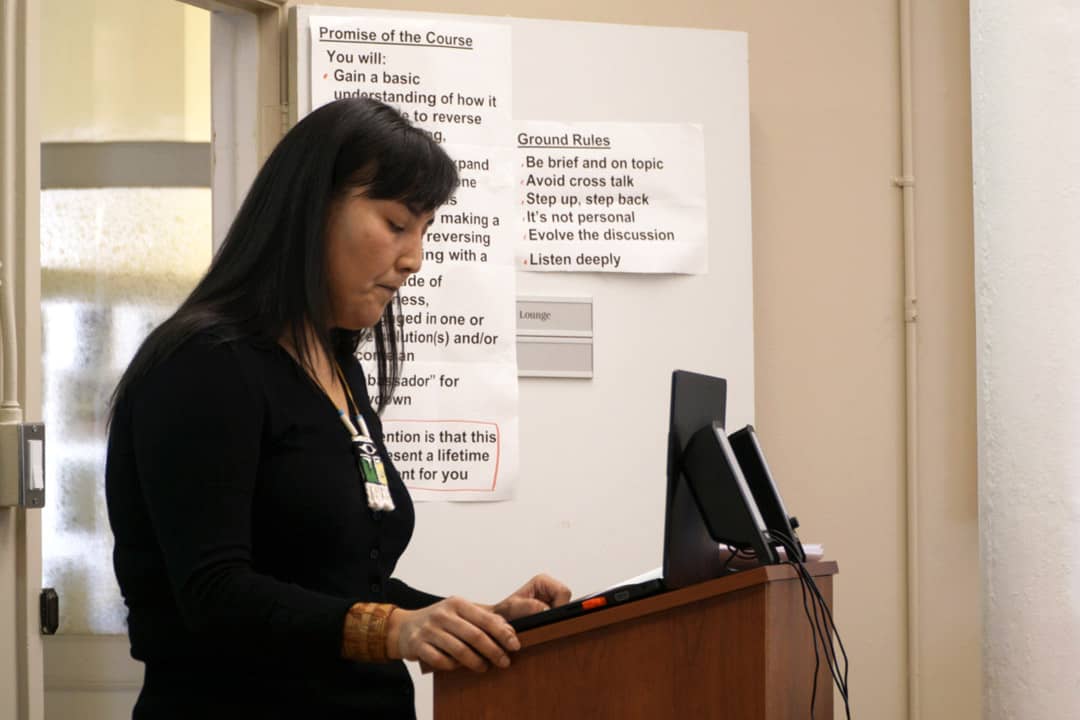The talk was titled “Access & Control of Indigenous Cultural Heritage: When the ‘Object’ of Repatriation is Song,” held in the First Nations House (FNH) on October 23. The event was part of Indigenous Education Week, an endeavour by FNH to celebrate Indigenous contributions and Indigenous presence on campus.
During her talk, Gray explained how ethnomusicologist Laura Boulton recorded songs of the Ts’msyen people — an Indigenous people of the Pacific Northwest — in 1942, and then sold the recordings to Columbia University in 1962.
At the time she sold them, Boulton created metadata for each recording — descriptive information about each recording. But, as Gray found in 2012, Boulton’s metadata was inaccurate.
“Columbia University provided me with the metadata for the collection,” said Gray, “which created an expectation that the recordings would be in order and that the Ts’msyen collection would be complete. But after researching and listening to every file — about a thousand of them in the Laura Boulton Collection — I discovered that Columbia only had an audio file for half of the Ts’msyen content.”
Columbia University not only underestimated the number of Ts’msyen songs in existence, but was also unaware of mistakes in Boulton’s written descriptions of the individual Ts’msyen recordings, according to Gray.
Dr. Aaron Fox, the Director of Columbia’s Center for Ethnomusicology, clarified that Columbia did not make any claims that the collection included all traditional songs of the Ts’msyen overall, “only a complete version of Boulton’s very amateur recordings of them.”
Fox also said that he worked closely with Gray on the issue of finding the missing audio.
According to Gray, nine of the Ts’msyen songs were attributed by Boulton to a Ts’msyen man named William Pierce. Boulton described Pierce as, “Eagle by birth, but Blackfish by adoption,” and claimed he “sang clan songs for her.”
But Gray said that Boulton’s lack of precision about Pierce’s heritage made it impossible for Boulton to verify whether his songs were Eagle or Blackfish, or if they were even “clan songs” at all.
Gray also criticized the titles of Boulton’s recordings as being “overly simplistic,” providing examples of Boulton categorizing songs as “Indian Songs” and “Folk Songs.”
Speculating on the reasons for the imprecision, Gray said that Boulton may have forgotten details as she “created the metadata for the recordings 20 years after the time of capture,” and that Boulton’s results were “typical of overly simplistic labels for classification given by someone who did not really understand the content, or the significance of it.”
Gray said that the inaccuracies resulted from a lack of consultation with the Ts’msyen people.
“As is typical in the early years of capturing, preserving, and representing Indigenous cultural heritage, Ts’msyen were not informed or consulted in any of these transfers and transactions. In all instances, Ts’msyen and oral histories were given new meanings and values ex situ — divorced from the appropriate sociocultural contexts, without consultation from the community.”
“In the Ts’msyen worldview,” wrote Gray in a 2018 peer-reviewed publication, “ownership is more synonymous with responsibility than it is with possession.”
But in the “Western property view,” said Gray in her presentation, “Ts’msyen never owned the copyright to the knowledge product, the tangible recording. Laura Boulton, the researcher, claimed ownership of it, then sold it and bequeathed it, and now multiple institutions control the means of access to our songs.”
Such access to Ts’msyen songs without proper context can encourage erroneous beliefs about Ts’msyen culture.
To provide proper context for Ts’msyen songs, they “must be put into the appropriate cultural context,” said Gray. Such a context would accurately answer questions such as, “Who composed the song? What’s the composer’s lineage? Why did they compose the song? Where does the song belong? Who has the rights to sing the song, and in what context?”
On the issue of the missing and incorrect metadata for the Ts’msyen song recordings, Fox said that such knowledge gaps are not unusual when collecting recordings of songs of Indigenous people.
“Such problems are endemic to such collections [as the Center’s collections of Navajo and Hopi recordings] and do point to a larger issue of colonialist mentality in the archiving of Indigenous recordings for sure,” said Fox.
Explaining how Gray helped Columbia complete the Boulton collection, Fox said, “What happened with the audio for the Boulton Ts’msyen recordings is that some of it wound up at the Indiana University archive of traditional music unlabelled.”
Fox and Gray “were able to determine that those unlabelled tapes were some of the missing audio.”
“So the pieces have been recovered — but that was a serendipitous thing had [Gray] not begun her inquiry when she did, and had not several clues aligned to point to looking at Indiana for missing audio.”
Gray concluded her talk by outlining her position on who should retain ownership of Ts’msyen song recordings, saying that institutions with ownership of “Indigenous cultural material” must “be prepared to give up control of Indigenous cultural heritage if that is what the source community wishes.”
This ownership would allow the Ts’msyen people to ensure that any listeners of the songs would experience them in their proper cultural context.
Update (November 8, 7:31 pm): This story has been updated to include comment from Fox.


